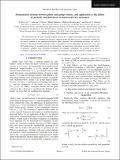| dc.contributor.author | Loh, Po-Ru | |
| dc.contributor.author | Oskooi, Ardavan | |
| dc.contributor.author | Ibanescu, Mihai | |
| dc.contributor.author | Skorobogatiy, Maksim | |
| dc.contributor.author | Johnson, Steven G. | |
| dc.date.accessioned | 2010-02-17T20:44:45Z | |
| dc.date.available | 2010-02-17T20:44:45Z | |
| dc.date.issued | 2009-06 | |
| dc.date.submitted | 2009-03 | |
| dc.identifier.issn | 1550-2376 | |
| dc.identifier.issn | 1539-3755 | |
| dc.identifier.uri | http://hdl.handle.net/1721.1/51780 | |
| dc.description.abstract | We demonstrate that the ratio of group to phase velocity has a simple relationship to the orientation of the electromagnetic field. In nondispersive materials, opposite group and phase velocity corresponds to fields that are mostly oriented in the propagation direction. More generally, this relationship (including the case of dispersive and negative-index materials) offers a perspective on the phenomena of backward waves and left-handed media. As an application of this relationship, we demonstrate and explain an irrecoverable failure of perfectly matched layer absorbing boundaries in computer simulations for constant cross-section waveguides with backward-wave modes and suggest an alternative in the form of adiabatic isotropic absorbers. | en |
| dc.description.sponsorship | Army Research Office, ISN | en |
| dc.description.sponsorship | National Science Foundation MRSEC Program | en |
| dc.description.sponsorship | National Defense Science and Engineering Council | en |
| dc.language.iso | en_US | |
| dc.publisher | American Physical Society | en |
| dc.relation.isversionof | http://dx.doi.org/10.1103/PhysRevE.79.065601 | en |
| dc.rights | Article is made available in accordance with the publisher's policy and may be subject to US copyright law. Please refer to the publisher's site for terms of use. | en |
| dc.source | APS | en |
| dc.title | Fundamental relation between phase and group velocity, and application to the failure of perfectly matched layers in backward-wave structures | en |
| dc.type | Article | en |
| dc.identifier.citation | Loh, Po-Ru et al. “Fundamental relation between phase and group velocity, and application to the failure of perfectly matched layers in backward-wave structures.” Physical Review E 79.6 (2009): 065601. © 2009 The American Physical Society. | en |
| dc.contributor.department | Massachusetts Institute of Technology. Department of Materials Science and Engineering | en_US |
| dc.contributor.department | Massachusetts Institute of Technology. Department of Mathematics | en_US |
| dc.contributor.approver | Johnson, Steven G. | |
| dc.contributor.mitauthor | Loh, Po-Ru | |
| dc.contributor.mitauthor | Oskooi, Ardavan F. | |
| dc.contributor.mitauthor | Johnson, Steven G. | |
| dc.relation.journal | Physical Review E | en |
| dc.eprint.version | Final published version | en |
| dc.type.uri | http://purl.org/eprint/type/JournalArticle | en |
| eprint.status | http://purl.org/eprint/status/PeerReviewed | en |
| eprint.grantNumber | DAAD-19- 02-D0002 | en |
| eprint.grantNumber | DMR- 0819762 | en |
| dspace.orderedauthors | Loh, Po-Ru; Oskooi, Ardavan; Ibanescu, Mihai; Skorobogatiy, Maksim; Johnson, Steven | en |
| dc.identifier.orcid | https://orcid.org/0000-0001-7327-4967 | |
| dspace.mitauthor.error | true | |
| mit.license | PUBLISHER_POLICY | en |
| mit.metadata.status | Complete | |
